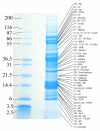Insight into the sialome of the Black Fly, Simulium vittatum
- PMID: 19166301
- PMCID: PMC2778207
- DOI: 10.1021/pr8008429
Insight into the sialome of the Black Fly, Simulium vittatum
Abstract
Adaptation to vertebrate blood feeding includes development of a salivary "magic potion" that can disarm host hemostasis and inflammatory reactions. Within the lower Diptera, a vertebrate blood-sucking mode evolved in the Psychodidae (sand flies), Culicidae (mosquitoes), Ceratopogonidae (biting midges), Simuliidae (black flies), and the frog-feeding Corethrellidae. Sialotranscriptome analyses from several species of mosquitoes and sand flies and from one biting midge indicate divergence in the evolution of the blood-sucking salivary potion, manifested in the finding of many unique proteins within each insect family, and even genus. Gene duplication and divergence events are highly prevalent, possibly driven by vertebrate host immune pressure. Within this framework, we describe the sialome (from Greek sialo, saliva) of the black fly Simulium vittatum and discuss the findings within the context of the protein families found in other blood-sucking Diptera. Sequences and results of Blast searches against several protein family databases are given in Supplemental Tables S1 and S2, which can be obtained from http://exon.niaid.nih.gov/transcriptome/S_vittatum/T1/SV-tb1.zip and http://exon.niaid.nih.gov/transcriptome/S_vittatum/T2/SV-tb2.zip .
Figures






Similar articles
-
An insight into the transcriptome and proteome of the salivary gland of the stable fly, Stomoxys calcitrans.Insect Biochem Mol Biol. 2009 Sep;39(9):607-14. doi: 10.1016/j.ibmb.2009.06.004. Epub 2009 Jul 2. Insect Biochem Mol Biol. 2009. PMID: 19576987 Free PMC article.
-
An insight into the sialome of the frog biting fly, Corethrella appendiculata.Insect Biochem Mol Biol. 2014 Jan;44:23-32. doi: 10.1016/j.ibmb.2013.10.006. Epub 2013 Oct 26. Insect Biochem Mol Biol. 2014. PMID: 24514880 Free PMC article.
-
An insight into the sialotranscriptome of the cat flea, Ctenocephalides felis.PLoS One. 2012;7(9):e44612. doi: 10.1371/journal.pone.0044612. Epub 2012 Sep 25. PLoS One. 2012. PMID: 23049752 Free PMC article.
-
An insight into the sialome of blood-feeding Nematocera.Insect Biochem Mol Biol. 2010 Nov;40(11):767-84. doi: 10.1016/j.ibmb.2010.08.002. Epub 2010 Aug 20. Insect Biochem Mol Biol. 2010. PMID: 20728537 Free PMC article. Review.
-
Black fly (Diptera:Simuliidae) salivary secretions: importance in vector competence and disease.J Med Entomol. 1997 Mar;34(2):87-94. doi: 10.1093/jmedent/34.2.87. J Med Entomol. 1997. PMID: 9103750 Review.
Cited by
-
Proteome of Hydra nematocyst.J Biol Chem. 2012 Mar 23;287(13):9672-9681. doi: 10.1074/jbc.M111.328203. Epub 2012 Jan 30. J Biol Chem. 2012. PMID: 22291027 Free PMC article.
-
Entomopathogenic Fungi and Bacteria in a Veterinary Perspective.Biology (Basel). 2021 May 28;10(6):479. doi: 10.3390/biology10060479. Biology (Basel). 2021. PMID: 34071435 Free PMC article. Review.
-
Comparative analysis of salivary gland transcriptomes of Phlebotomus orientalis sand flies from endemic and non-endemic foci of visceral leishmaniasis.PLoS Negl Trop Dis. 2014 Feb 27;8(2):e2709. doi: 10.1371/journal.pntd.0002709. eCollection 2014 Feb. PLoS Negl Trop Dis. 2014. PMID: 24587463 Free PMC article.
-
Skin Lesions and Systemic Reactions in Humans Infested by Blackflies (Diptera: Simullidae) in Recreational Areas in Southeastern Poland.J Clin Med. 2021 Feb 16;10(4):788. doi: 10.3390/jcm10040788. J Clin Med. 2021. PMID: 33669296 Free PMC article.
-
Anopheline salivary protein genes and gene families: an evolutionary overview after the whole genome sequence of sixteen Anopheles species.BMC Genomics. 2017 Feb 13;18(1):153. doi: 10.1186/s12864-017-3579-8. BMC Genomics. 2017. PMID: 28193177 Free PMC article.
References
-
- Ribeiro JM, Francischetti IM. Role of arthropod saliva in blood feeding: sialome and post-sialome perspectives. Annu. Rev. Entomol. 2003;48:73–88. - PubMed
-
- Cupp EW, Mare CJ, Cupp MS, Ramberg FB. Biological transmission of vesicular stomatitis virus (New Jersey) by Simulium vittatum (Diptera: Simuliidae) J Med Entomol. 1992;29(2):137–40. - PubMed
-
- Mead DG, Mare CJ, Cupp EW. Vector competence of select black fly species for vesicular stomatitis virus (New Jersey serotype) Am J Trop Med Hyg. 1997;57(1):42–8. - PubMed
-
- Freedman D. Onchocerciasis. 2 ed Churchill Livingstone; Philadelphia: 2005. Chapter 100; p. 1176.
-
- Bernardo MJ, Cupp EW, Kiszewski AE. Rearing black flies (Diptera: Simuliidae) in the laboratory: bionomics and life table statistics for Simulium pictipes. J Med Entomol. 1986;23(6):680–4. - PubMed
Publication types
MeSH terms
Substances
Grants and funding
LinkOut - more resources
Full Text Sources
Other Literature Sources
Research Materials

